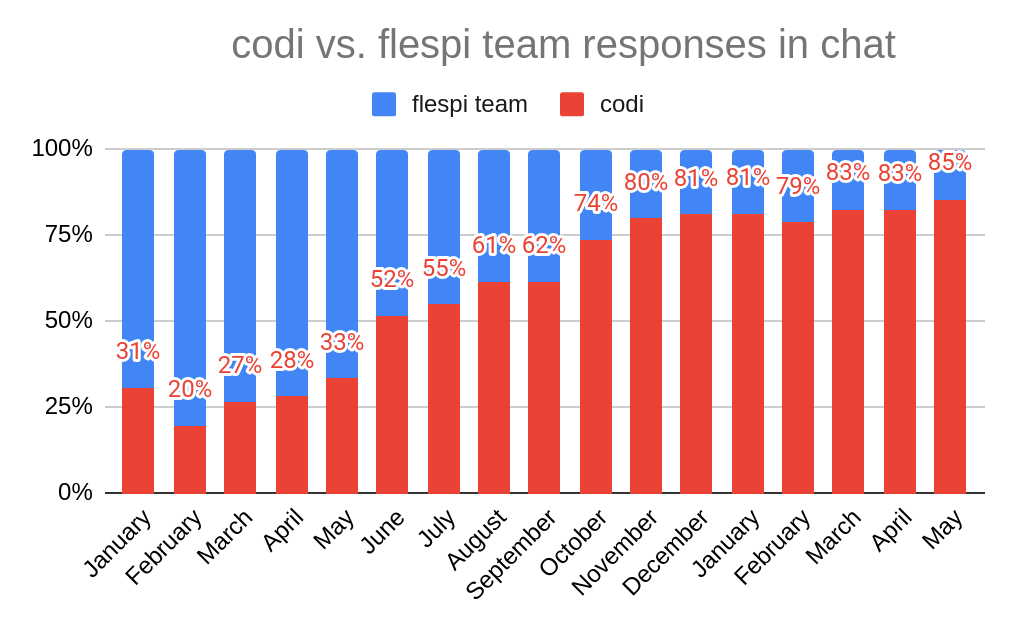Nature has its way of returning the favor for all the harm we inflict upon it. This May in Lithuania was cold and wet – more like March than late spring – with only the last week bringing any warmth. Some mornings, I even spotted frozen windows on cars parked outside! But there's always a silver lining to bad weather: it keeps the team indoors and focused. This May was no exception – we dove deep into complex engineering tasks across flespi, strengthening both our backend core and mid-level functionality. Tacho and video telematics received significant attention, and we finally brought the long-awaited assets feature into flespi analytics.
In May, our uptime was 99.9682%, with a scheduled maintenance operation that reminded us why "scheduled" doesn't always mean "predictable." On May 27, during routine datacenter switch replacement, we experienced two severe service interruptions (258 and 504 seconds) when a fiber link to our secondary gateway in one datacenter was inadvertently disconnected. This triggered what we call a "split-brain" situation – the secondary gateway, having lost its LAN connectivity, still attempted to handle all traffic despite being unable to actually route it anywhere. The full technical explanation is available in our NOC, but the short version is: even the most carefully planned maintenance can surprise you when a loose fiber connector decides to play havoc with your failover logic.
Unlike the dramatic datacenter blackout we faced in April, this incident was contained quickly by manually switching operations to the primary gateway. Still, it served as another reminder that infrastructure work – even when scheduled, coordinated, and monitored – carries inherent risks.
Assets are rapidly approaching production-ready status. We've added access to asset intervals in flespi analytics and fully documented them. We're now testing their application with our most demanding users and considering automatic synchronization of asset intervals based on device-level events – from iButton and BLE tags to AI-based driver face recognition from cameras, and even extracting driver information from .ddd files downloaded from tacho-enabled devices.
We've committed numerous improvements to stabilize and enhance the durability of .ddd file retrievals from tachographs. The system now works very reliably, and as new tacho users join us, we continue to discover and handle edge cases.
Meitrack has joined the club of video-enabled devices integrated into flespi. Thanks to our established technology stack, the integration took just a single day – incredibly quick by any standard.
In May, codi received significant intelligence upgrades that fundamentally changed how it assists flespi users. The AI assistant's improved auto-follow-up functionality now provides sophisticated proactive engagement, automatically detecting and responding to unattended support requests, especially during non-business hours. Advanced reasoning capabilities enable codi to tackle increasingly complex multi-step problems – from intricate device configurations to advanced analytics setups. These improvements, combined with more natural communication patterns that better understand context and adapt to user expertise levels, have resulted in codi handling 85% of May's support interactions autonomously while maintaining the technical accuracy and depth that flespi users expect.
We've been incredibly satisfied with codi's performance since the very beginning. The way it handles support communication, assists our users with project implementation, promotes flespi capabilities, and supports our team in various tasks – even the most advanced ones – has exceeded expectations. It's no longer an intern but rather a confident and highly proficient partner. Given all this, we've decided to officially place codi on our team page.
In June, we'll continue refactoring our backend components to squeeze even more performance from our existing hardware infrastructure. And finally, we'll enjoy the beginning of vacation season, hopefully resting a bit before the next fruitful (and cold) season.
